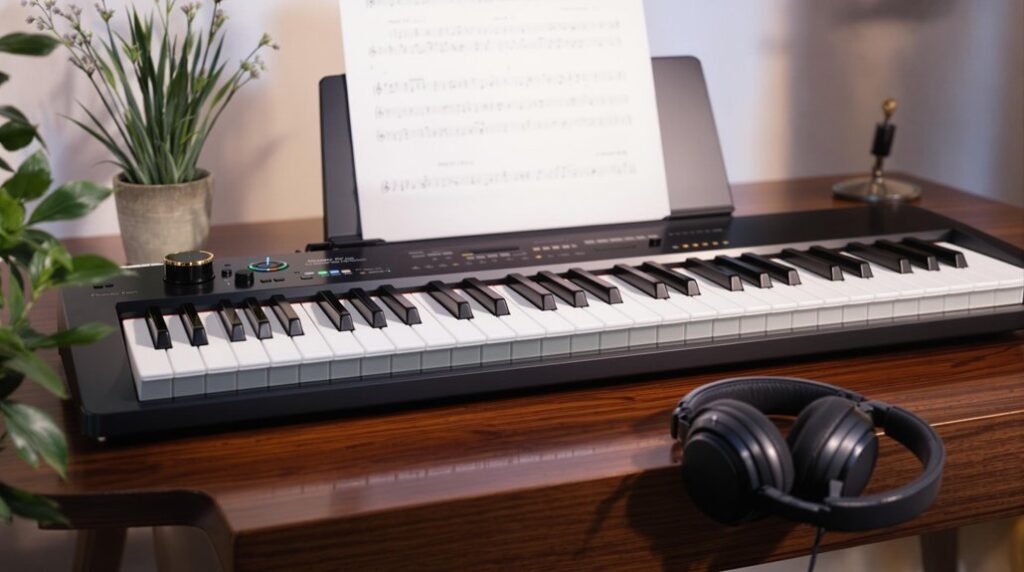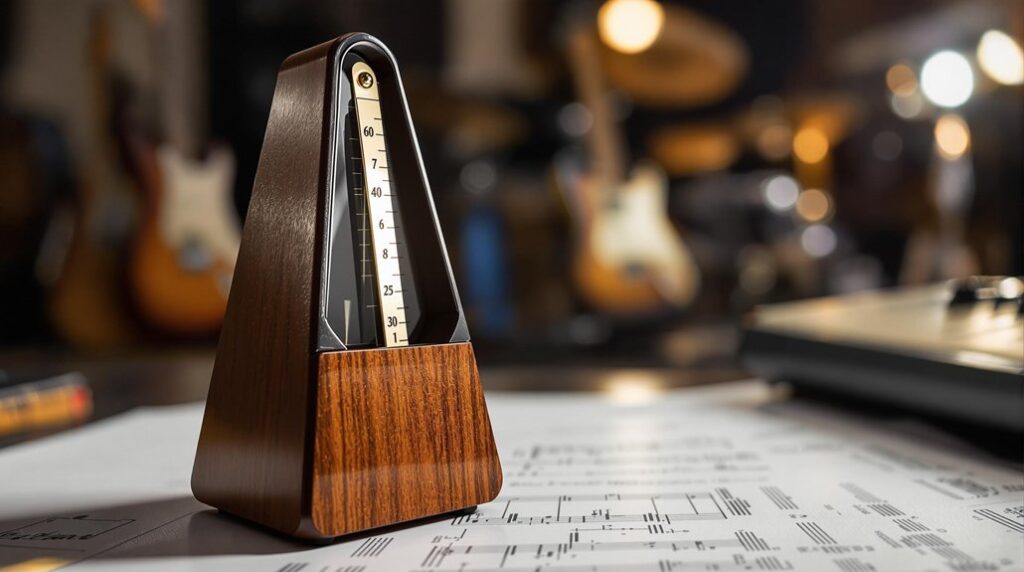Music modes fundamentally shape Western music theory, offering producers templates to evoke diverse emotions. The Ionian mode‘s bright tonality contrasts with the Aeolian’s melancholic hues, crafted through specific intervallic structures. Dorian mode‘s blend of minor harmony with a major sixth enriches blues and jazz compositions, while Phrygian’s exotic flair adds layered tension. Modal interchange and modulation uplift compositions, alongside advanced techniques like pivot chords for seamless key shifts. Mastery of these concepts enhances production skills, underpinned by robust theoretical knowledge. For producers, embracing these personas of sound reveals deeper creative potential and further artistic insight awaits.
Key Takeaways
- Music modes are foundational in Western music, shaping emotional resonance and harmonic structure.
- Ionian and Aeolian modes provide bright and melancholic tonalities respectively, influencing emotional depth in compositions.
- Modal interchange and pivot chords enable smooth transitions and innovative chord progressions in music production.
- Understanding music theory enhances production skills, aiding in effective scale, mode, and chord progression use.
- DAWs like Bitwig and Ableton offer modular design and live performance features, essential for creative music production.
Overview of Music Modes
Music modes, fundamental to Western music theory, are distinct scales that shape the emotional and tonal terrain of compositions.
The Ionian mode, synonymous with the major scale, exudes brightness and uplift. In contrast, the Aeolian mode, mirroring the natural minor scale, evokes melancholic depth.
The Dorian mode introduces a unique blend, integrating minor tonalities with a major sixth, striking a balance between somber and light. Meanwhile, the Phrygian mode, defined by its lowered second degree, injects an exotic tension into musical narratives.
Each mode offers composers a palette of emotional colors, influencing the listener’s perception and experience. These modes form the backbone of harmonic progressions and melodic structures, providing a versatile framework for musical expression and innovation.
Ionian Mode Dynamics
While foundational in Western music theory, the Ionian mode is not just a theoretical construct but a vibrant tool for musical storytelling. Essentially, it mirrors the major scale, characterized by the interval pattern of whole step, whole step, half step, followed by three whole steps and a final half step. This structure is exemplified in the C major scale’s notes: C-D-E-F-G-A-B-C.
In musical compositions, the Ionian mode fosters robust chord progressions, typically featuring the tonic (I), subdominant (IV), and dominant (V) major chords, creating emotional resonance.
Skilled use of scale degrees enhances melody and rhythm.
- Common chord progression: I-IV-V
- Emphasizes strong tonic and dominant scale degrees
- Produces seven unique chords, including major and minor variations
Moreover, the Ionian mode’s major chords contribute to its emotional impact, allowing composers to evoke feelings of joy and resolution.
Dorian Mode Applications
Building on the foundational Ionian mode, the Dorian mode offers a compelling alternative for composers and musicians seeking a nuanced harmonic palette.
Characterized by its minor tonic and distinctive raised sixth, the Dorian mode blends minor melancholy with a hint of brightness. Common chord progressions such as i – IV – vii° – i and i – IV – v – i provide a structured framework, facilitating both emotional expression and creative exploration.
In genres like jazz, rock, and blues, the Dorian mode’s unique qualities evoke a blend of tension and resolution. Improvisation techniques often emphasize the raised sixth, acting as a melodic linchpin.
Iconic tracks like “Scarborough Fair” and “Oye Como Va” showcase its versatility in popular music.
Phrygian Mode Insights
The Phrygian mode, with its inherent exoticism, captivates musicians and composers through its distinctive lowered second degree. This scale’s structure—root, minor second, minor third, perfect fourth, perfect fifth, minor sixth, minor seventh—imbues compositions with an exotic flavor and emotional depth.
Its darker tonal qualities are particularly favored in genres such as metal, jazz, and flamenco, where the tension created is both intense and evocative.
Leveraging modal interchange, producers can inject the Phrygian mode into tracks, creating unexpected harmonic twists that refresh and transform traditional compositions.
Songs like “Trainer Battle Music” and “MONTERO” exemplify this mode’s ability to evoke complexity and intrigue.
- Phrygian mode adds exotic flavor.
- Promotes emotional depth in music.
- Enables innovative modal interchange.
Lydian Mode Techniques
Lydian mode, distinguished by its raised fourth scale degree, offers musicians a gateway to creating ethereal and dreamy sound environments. The mode’s bright and stable nature is ideal for crafting melodies and harmonies that emphasize its distinctive sound. Commonly used in progressive rock and film scores, Lydian modes allow for innovative harmonic structures. By focusing on the unique ♯4, composers can explore rich textures and unique tonal qualities. Layering chords, utilizing inversions, and extensions enhance the complexity of Lydian compositions. This approach not only highlights the raised fourth but also guarantees melodic cohesion across the scale. Understanding harmonic blending in DJ mixing can further deepen the emotional resonance of Lydian compositions.
| Technique | Description | Application |
|---|---|---|
| Raised Fourth | Distinctive sound of Lydian | Melodies and harmonies |
| Chord Progression | Emphasizes ♯4 | Innovative harmonic structures |
| Layering Chords | Inversions and extensions | Complex musical environment |
| Melodic Focus | Highlights raised fourth | Guarantees melodic cohesion |
| Genre Usage | Progressive rock and film scores | Evokes wonder and exploration |
Mixolydian Mode Creativity
The Mixolydian mode‘s distinct flattened seventh infuses compositions with a unique blend of brightness and blues, providing a compelling sonic palette that captivates audiences.
Musicians often exploit this mode’s potential by employing chord progressions such as I-IV and I-bVII, which offer invigorating variations to conventional major harmonies. Additionally, the incorporation of modal interchange can further enhance a composition’s harmonic complexity, creating fresh and engaging musical experiences.
Blend Brightness and Blues
Few musical modes offer the dynamic interplay of brightness and bluesy tension quite like the Mixolydian mode, making it an essential tool for composers seeking creative innovation.
Distinguished by its major scale structure with a flattened seventh, the Mixolydian mode bridges the bright tonalities of the Ionian with the emotional depth of blues-inflected sounds. This mode’s signature unresolved yearning, as heard in tracks like “Sweet Home Alabama,” lends itself to genres such as rock and jazz.
- Expressive Melodies: Craft emotionally engaging melodies with Mixolydian’s unique tonal qualities.
- Chords with Tension: Utilize I-IV and I-V progressions to enhance listener engagement.
- Diverse Genre Appeal: Suitable for rock, jazz, and beyond, offering versatility in composition.
Producers can integrate Mixolydian elements for innovative tracks with fresh sonic environments.
Innovative Chord Progressions
Harnessing the unique qualities of the Mixolydian mode can lead to innovative chord progressions that breathe new life into compositions. Characterized by its flattened seventh degree, this mode injects a bluesy tension that is particularly effective in rock and blues music production.
Traditional I-IV-V progressions gain a fresh twist by incorporating the bVII chord, enhancing harmonic depth and listener intrigue. Such modal interchange revitalizes familiar progressions, facilitating creative exploration.
Highlighting the Mixolydian’s b7 in melodies further contrasts with the Ionian mode, offering a new sonic palette. By borrowing chords from the Mixolydian mode, producers can augment existing compositions, inviting novel musical directions and rejuvenating established frameworks.
This approach not only enriches harmonic vocabulary but also sparks innovative artistry.
Aeolian Mode Characteristics
The Aeolian mode, or natural minor scale, is distinguished by its emotional depth, primarily stemming from its flattened 6th and 7th degrees which imbue it with a poignant, melancholic quality.
This mode’s intervallic structure—whole, half, whole, whole, half, whole, whole—allows for the creation of somber melodic lines and harmonic progressions, such as i – iv – v, that are foundational to its expressive capacity.
Frequently employed in rock, pop, and classical compositions, the Aeolian mode offers composers a versatile palette for crafting narratives rich in emotional nuance and harmonic complexity.
Emotional Depth Exploration
In the field of music composition, the Aeolian mode serves as a profound tool for exploring emotional depth, with its unique tonal characteristics inviting introspection and complexity. Known as the natural minor scale, the Aeolian mode diverges from the Ionian modes interval by incorporating flattened 6th and 7th degrees, creating a somber, melancholic sound.
Its capacity for emotional storytelling makes it a versatile asset in minor modes, adept at evoking different emotions through its distinct interval pattern. Producers harness this mode to craft rich, introspective pieces that resonate with the listener.
- Chord Progressions: Emphasize minor tonic with i – IV – v – i.
- Mood: Often perceived as the saddest of musical modes.
- Genre Versatility: Suits ballads and introspective compositions.
Melancholic Melodic Structures
Exploring the Aeolian mode reveals its capacity to craft melancholic melodic structures that resonate deeply with listeners. Defined by its scale formula—root, major second, minor third, perfect fourth, perfect fifth, minor sixth, and minor seventh—it produces a melancholic sound enriched with emotional depth.
The flattened sixth and seventh degrees contribute to its wistful character, often dubbed the saddest of musical modes. This mode’s tonal qualities excel in genres like ballads, rock, and pop, where rich storytelling is paramount.
Chord progressions such as i – iv – v leverage the minor tonic, amplifying the mode’s inherent nostalgia and longing. Through strategic harmonizing melodies, the Aeolian mode becomes a powerful tool for composers seeking to evoke profound emotional terrains.
Harmonization Techniques Explained
Explore the art of harmonization within the Aeolian mode, where the interplay of minor chords and flattened degrees crafts an unmistakable somber tone. This mode, synonymous with the natural minor scale, utilizes a tonic chord foundation to evoke rich emotional vistas.
Harmonizing in the Aeolian mode involves strategically crafting progressions like i – iv – v and i – VI – III – VII, which serve as a canvas for expressive storytelling. The inclusion of modal interchange, borrowing chords from related modes, can introduce invigorating shifts that maintain listener engagement.
- Layering Harmonies: Employ parallel motion and counterpoint for complexity.
- Emotional Resonance: Use flattened sixth and seventh degrees for wistfulness.
- Dynamic Textures: Incorporate modal interchange for unexpected variations.
Locrian Mode Exploration
The enigmatic nature of the Locrian mode presents a fascinating challenge for composers and musicians alike. Characterized by its diminished triad, the Locrian mode inherently exudes dissonance, often eschewing a clear tonic resolution. This creates a distinct tonal tension that demands innovative approaches in musical compositions.
Its scale formula—root, minor second, minor third, perfect fourth, diminished fifth, minor sixth, and minor seventh—contributes to its perception as the least stable of all modes. Despite this, the Locrian mode finds its niche in genres that embrace such tension, like experimental music, jazz, and metal.
Composers often resolve to a major tonic to anchor the inherent instability, crafting a cohesive sound while exploring the mode’s intricate and challenging terrain.
Advanced Modal Concepts
Advanced modal concepts in music composition, such as modal interchange techniques and key modulation strategies, serve as powerful tools in enhancing tonal variety and emotional depth.
By integrating chords from different modes and utilizing pivot chords for seamless shifts, composers can craft unique harmonies and dynamic changes that captivate listeners.
These sophisticated approaches not only enrich musical narratives but also encourage a more nuanced exploration of modal possibilities.
Modal Interchange Techniques
Maneuvering through the intricate terrain of modal interchange techniques reveals a treasure trove of harmonic possibilities for composers seeking to deepen their musical expression.
Modal interchange involves borrowing chords from parallel modes, such as integrating Dorian chords in an Ionian foundation, enhancing harmonic textures and emotional depth. This technique introduces unexpected chord progressions, enthralling listeners and enriching a piece’s structural complexity.
Maintaining a clear tonal center guarantees that these shifts guide the listener through varied moods and harmonic flavors seamlessly.
- Examples: Shift from Ionian to Aeolian for minor chord introduction.
- Practice: Substitute chords from parallel modes while retaining the key.
- Result: Richer harmonic palettes and engaging musical narratives.
Mastery of modal interchange can greatly raise compositional artistry.
Key Modulation Strategies
While maneuvering through the intricate terrain of key modulation strategies, composers can reveal new dimensions of musical intrigue by altering the tonal center of a composition.
Key modulation, achieved via whole or half steps, introduces contrast, keeping the listener engaged. Utilizing pivot chords, which exist in both the original and target keys, guarantees smooth shifts between key areas, whether major or minor.
Techniques such as chromatic and common-tone modulation maintain thematic coherence amid these changes. Additionally, modal interchange allows producers to borrow chords from parallel modes, enriching harmonic textures and emotional depth.
Understanding the relationships between modes, especially their shared notes, facilitates seamless shifts, ultimately enhancing the composition’s narrative and complexity.
This sophisticated approach transforms musical environments with innovative flair.
Enhancing Tonal Variety
Building upon the intricate strategies of key modulation, composers can further enrich their musical environments through advanced modal concepts, thereby enhancing tonal variety.
By employing modal interchange, producers craft unexpected harmonic twists that heighten emotional impact. For instance, shifting from Ionian to Dorian introduces borrowed chords, infusing tracks with dynamic tonal color.
Layering chords from diverse modes, such as blending Lydian’s sharp fourth with Ionian’s vibrant tonality, adds unparalleled texture and depth. This approach also encourages the exploration of non-diatonic chords, leading to innovative progressions that captivate listeners.
- Modal Interchange: Borrow chords from alternative modes to surprise and engage.
- Layering Chords: Combine elements from different modes for enhanced depth.
- Unexpected Harmonic Twists: Create fresh and compelling sonic experiences.
Resources for Music Production
For music producers seeking to refine their craft, harnessing the right resources is imperative. A solid foundation in music theory, particularly understanding the Ionian mode and the chords built around it, is vital for crafting sophisticated electronic music.
The Ultimate Ionian Scales MIDI Collection, with its extensive library of over 1,100 MIDI files, offers an invaluable toolkit for exploring scales, progressions, and melodies across genres. Complementing this, online courses and literature focused on music theory fundamentals enhance a producer’s theoretical proficiency.
Mastery of DAWs like Bitwig and Ableton, known for their modular sound design and live performance capabilities respectively, is essential. Additionally, employing audio effects like phasers enriches sound textures, while continuous learning propels creative evolution in music production. Understanding chord progressions can significantly influence the emotional impact of your tracks.
Frequently Asked Questions
What Are All 7 Major Scale Modes?
The seven major scale modes include: Ionian characteristics (brightness), Dorian vibe (minor with a raised sixth), Phrygian feel (darkness), Lydian sound (ethereal), Mixolydian groove (bluesy tension), Aeolian (melancholy), and Locrian (instability).
What Is the Mnemonic for the Musical Modes?
The mnemonic “I Don’t Particularly Like Mice A Lot” aids in recalling musical modes—Ionian, Dorian, Phrygian, Lydian, Mixolydian, Aeolian, Locrian. Understanding modal characteristics, applications, improvisation, and historical significance enhances their emotional impact in compositions.
What Is the Saddest Music Mode?
The Aeolian mode, a cornerstone of minor scales, is renowned for crafting sorrowful melodies and rich musical expressions. Its melancholic themes and profound emotional impact make it the quintessential choice for composers seeking to evoke deep, introspective emotions.
How to Understand Modes in Music?
Understanding modes in music involves analyzing musical scales to identify mode characteristics, which influence the emotional impact. Recognizing historical significance and applying improvisation techniques enriches compositional diversity, allowing the integration of varied tonalities and expressive possibilities.
Conclusion
In conclusion, the exploration of music modes offers an extensive framework for music producers to enhance their compositional and production skills. By understanding the distinct characteristics and applications of each mode—Ionian, Dorian, Phrygian, Lydian, Aeolian, and Locrian—producers can enrich their musical palette and innovate within various genres. Advanced modal concepts further expand creative potential, providing a robust foundation for sophisticated musical expression. Access to specialized resources can facilitate the integration of these modal techniques into professional music production practices.




